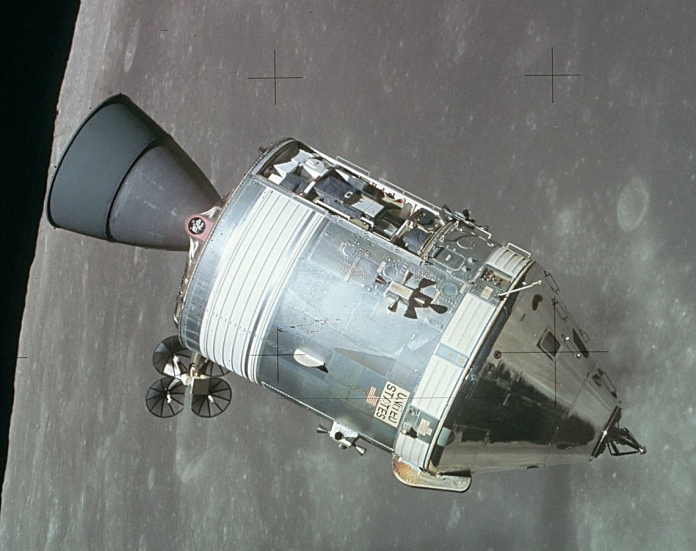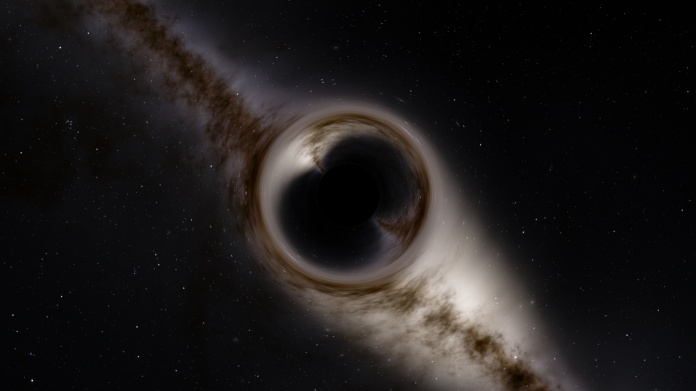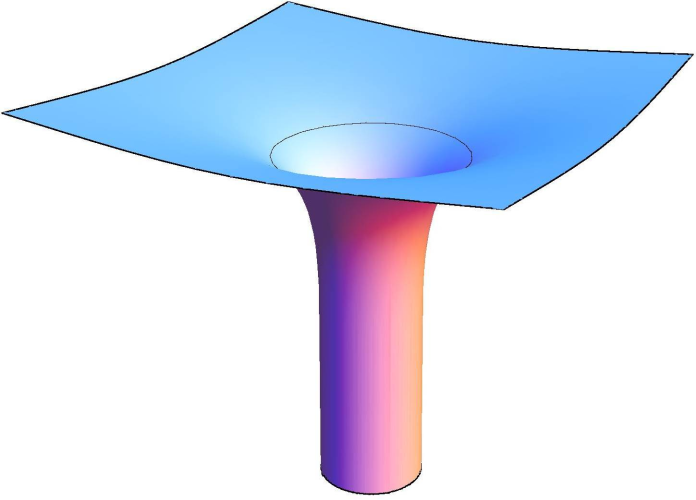In the previous part of this series, I tried to analyze what it would be like to fly an Apollo Command Module into black holes of various sizes. This time, though, I’m going to restrict myself to a single 1-million-solar-mass black hole. The difference is that, this time, I’m going to let the black hole spin (at 98% of the maximum possible spin, which is pretty average for a fast-spinning hole). But I’m getting ahead of myself. Before I go on, here’s my vehicle:
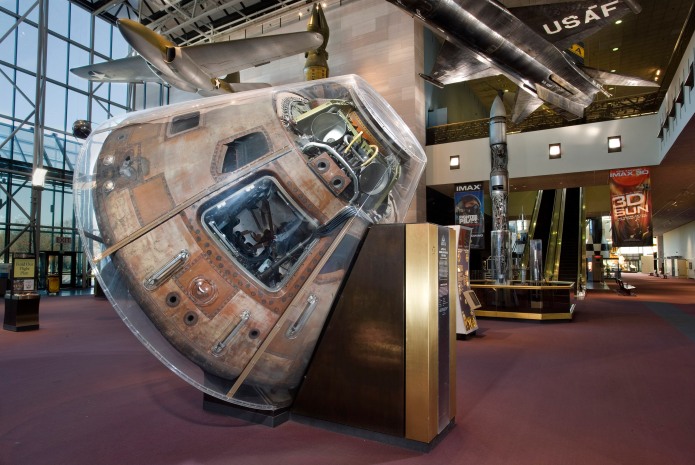
(From the website of the Smithsonian Air and Space Museum)
That’s the actual command module Michael Collins, Buzz Aldrin, and Neil Armstrong took to the Moon (minus the Plexiglas shroud, of course). It would fit in even a medium-sized living room. This time, the crew will consist of me, Jürgen Prochnow (Das Boot Jürgen, naturally. Captain’s hat and all), and Charlize Theron. I was gonna take David Bowie and Abe Lincoln along again, but frankly, I’ve put Bowie through enough, and Lincoln was just so damn grim all the time.
Anyway, back to the subject at hand: the scary monster that is a rapidly-spinning black hole. All the black holes I discussed in the last part were Schwarzschild black holes, meaning they had no spin or electric charge. This black hole, though, is a Kerr black hole: it spins. The spin means this trip is a whole new ballgame. We’re still going to die horribly, of course, but hey, at least it’ll be interesting.
The first difference is that you can get closer to the event horizon of a spinning black hole. For a non-spinning black hole, there are no stable circular orbits closer than one and a half times the radius of the event horizon (the Schwarzschild radius), because in order to be in a circular orbit any closer, you’d have to travel faster than light. For spinning ones, there’s a lozenge-shaped region outside the event horizon called the ergosphere (My first-born daughter will be Ergosphere Sullivan). Objects near a rotating hole (or any rotating mass, to a lesser extent) are dragged along with the hole’s rotation. But inside the ergosphere, though, they’re being dragged along so fast that, no matter what, they can’t stand still. Inside the ergosphere, you have to rotate with the hole, because traveling anti-spinward would require going faster than the speed of light.
Here’s roughly what a free-fall trajectory into our Kerr black hole would look like (looking down at the hole’s north pole):
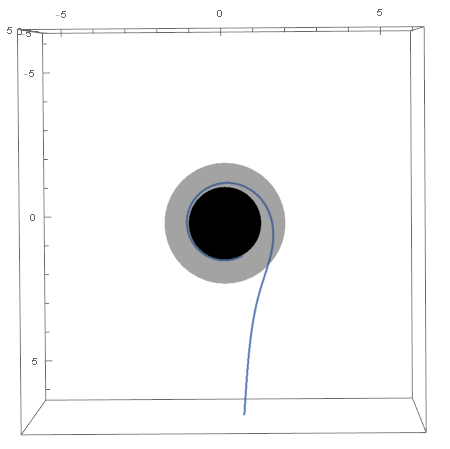
The ergosphere is the gray part. The event horizon is the black part.
Jürgen and Charlize are suspicious of me, but I gave them my word that we’re just orbiting the black hole. To make some observations. For science, and all that. When they’re not looking, I’m gonna hit the retro-rocket and plunge us to our deaths. I feel like there’s a flaw in my reasoning, but I don’t have time for such things.
Even orbits don’t work the way they normally do, near a spinning hole. Orbits around ordinary objects are very close to simple ellipses or circles. But, sitting in our command module, here’s what our orbit looks like (starting from parameters that should have given us a nice elliptical orbit):
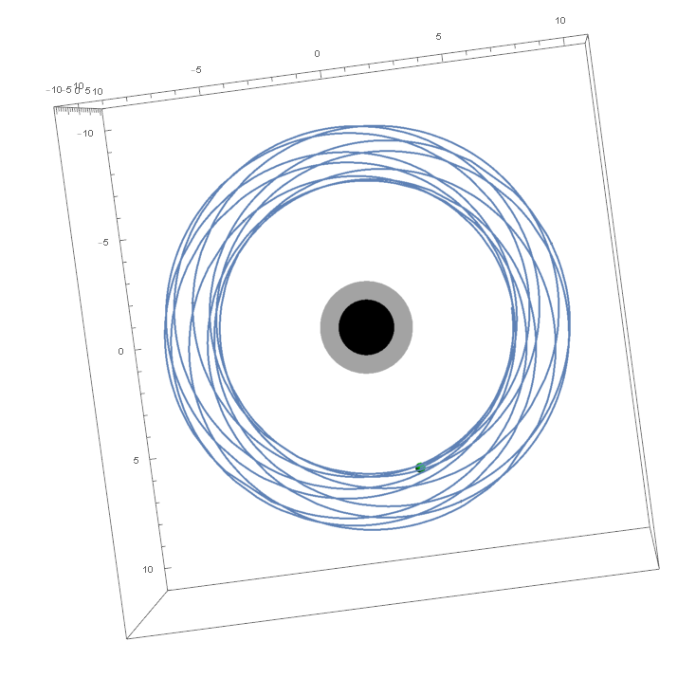
This is because, when we orbit closer to the hole, we get a kick from the spin that twists our orbit around.
From nearby, a non-rotating black hole looks like its name: a black circle of nothingness, surrounded by a distorted background of stars and galaxies. From our orbit around the spinning million-solar-mass hole, though, the picture is much different:
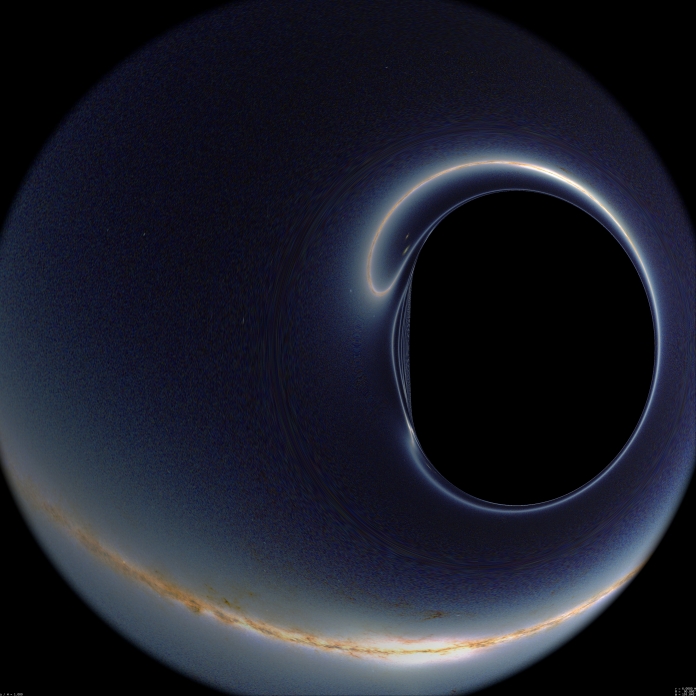
(Picture and simulation by Alain Riazuelo.)
In that picture, the hole’s equator rotates from left to right. The reason the horizon is D-shaped is that photons coming from that direction were able to get a lot closer to the horizon, since they were moving in the direction of the rotation. On the opposite side, the horizon is bigger because those photons were going upstream, so to speak, and many of them were pulled to a halt by the spin and then either pulled into the hole, flung away, or pulled into a spinward orbit. Black holes are bullies. Spinning ones say “If you get too close, I’m going to eat you. And if you’re standing within a few arm’s lengths, you have to spin around me, or else I’ll eat you.”
(Incidentally, if you read about the movie’s background, the black hole in Interstellar was spinning at something like 99.999999% of the maximum rate. Its horizon would have been D-shaped like the picture above, from up close. From a distance, it would have looked…well, it would have looked like it did in the movie. They got it right, because they hired Kip motherfucking Thorne, Mr. Black Hole himself, to help write their ray-tracing code.
Speaking of Interstellar, the fact that you can get so much closer to a spinning black hole than a non-spinning one (providing you’re orbiting spinward) means you can get much deeper into its time-dilating gravity well. That means, as long as the tides aren’t strong enough to kill you, you can experience much bigger timewarps. The only way to get the same timewarp from a non-rotating black hole is to apply horrendously large forces to hover just outside the horizon. It’s much more practical to do in the vicinity of a spinning hole. Well, I mean, it’s no less practical than putting a Command Module in orbit around a black hole.
According to the equations from this Physics Stack Exchange discussion, as Jürgen, Charlize, and I zip around the hole close to the innermost stable orbit, time is flowing upwards of four times slower than it is for observers far away. I’m gonna keep us in orbit for a week, to lull my crewmates into complacency, so I’ll have the element of surprise when I try to kill us all. Well, we think it’s a week. Everyone outside thinks we’re orbit for a month and change
Then, without warning, I flip us around, turn on the engines, and take us into the hole. Jürgen fixes me with those steely blue eyes and that pants-shittingly intimidating face he was doing all through Das Boot. Charlize spends fifteen seconds trying to reason with me, then realizes I’m beyond all help and starts beating the shit out of me. Did you see Fury Road? She can punch. Neither of them can do anything to stop me, though: we’re already seconds from death.
But because this is a big black hole, the tides are gentle, at least outside the horizon. They’re stronger than the tides the Moon exerts on the Earth (which are measured in hundreds of nanometers per second per second), but they’re not what’s going to tear us to pieces.
What’s going to tear us to pieces is frame-dragging. Let’s go back to the metaphor of the whirlpool. The water moves much faster close to the center than it does far away. Because your boat is a physical object with a non-zero size, when you get really close, the water on one side of your boat is moving significantly faster than the water on the other side, because the near side is significantly closer than the far side. This blog hasn’t had any horrible pictures recently. Here’s one to explain the frame-dragging we experience:
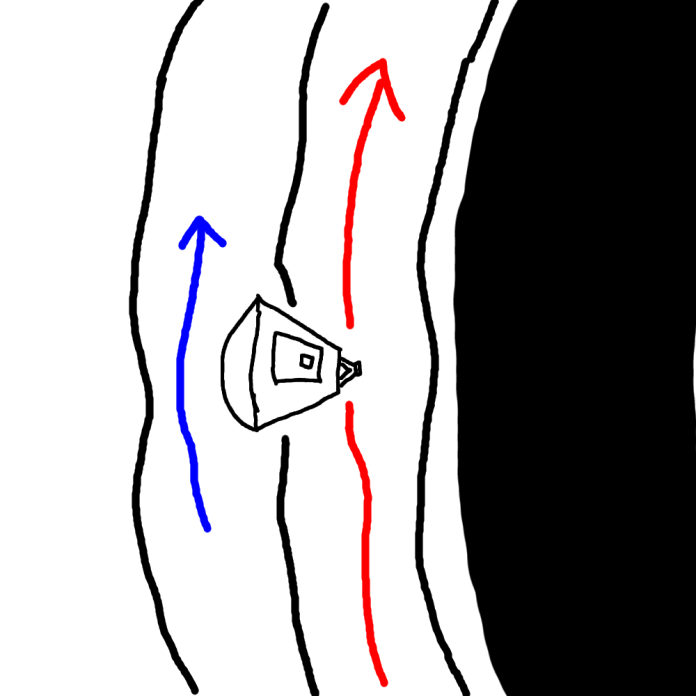
In this picture, the capsule orbits bottom-to-top, and the hole rotates clockwise (this is the opposite of the view in the orbit plots; in this picture, we’re looking at the hole from the bottom, looking at its south pole; the reason has nothing to do with the fact that I screwed up and drew my horrible picture backwards).
Space closer to the hole is moving faster than space farther from the hole. The gradient transfers some of the hole’s angular momentum to the capsule, which is bad news, because that means the capsule starts spinning. It spins in the opposite direction of the hole (counter-clockwise, in the Horrible Picture (TM)).
I say the spin is bad news because, from the research for “Death by Centrifuge“, I know that things get really messy and horrible if you’re in a vehicle that rotates too fast.
Here’s a fun fact: Neil Armstrong came perilously close to death on his first spaceflight. During Gemini 8, while Armstrong and crewmate Dave Scott were practicing station-keeping and docking maneuvers with an uncrewed Agena target vehicle, the linked spacecraft started spinning. Unbeknownst to them, one of the Gemini capsule’s thrusters was stuck wide-open. Thinking it was the Agena causing the problem, they undocked. That’s when the shit really hit the fan, though I think Armstrong probably described it more gracefully. A video is worth a thousand words: here’s what it looked like when they undocked. Before long, the capsule was tumbling at 60 revolutions per minute (1 per second), wobbling around all three axes.
Did you ever spin in a circle when you were a kid? I did. Did you ever try it again as an adult, just to see what it was like? I did. I spent the next fifteen minutes lying in the grass (because I couldn’t tell which way was down) wondering if I should just go ahead and puke. Human beings don’t handle rotation well. According to this literature survey (thanks to Nyrath of Project Rho for helping direct me to it; it was hell to try and find a proper paper otherwise), average people do okay spinning at 1.7 RPM. At 2.2 RPM, susceptible people will probably start puking everywhere. At 5.44 RPM, ordinary tasks become stressful, because, thanks to the Coriolis effect (that troublemaking bastard), things like limbs, bodies, and inner-ear fluid don’t move normally, which plays hell with coordination. Also, it makes you puke. At 10 RPM, even the tough subjects in the study were seriously distressed.
Armstrong and Scott were spinning six times faster. When you spin, your brain loses the ability to compensate for movements of the eyes: you lose the ability to stabilize the image on your retinas, and the world wobbles and jumps. That’s bad news, especially if, for instance, you’re stuck inside a metal can which is spinning way too fast, and the only way you can stop it spinning way too fast (so that you don’t die) is by focusing your eyes on buttons and moving your Coriolis-afflicted hands to press them. Armstrong was an especially tough, calm dude, and he managed it, even though both men were starting to have serious vision problems. He did what any good troubleshooter would do: he switched the thrusters off and then on again (more or less). That saved the mission.
Now, I don’t know how fast the black hole will spin us, because the math is very complicated. But considering it’s a black hole we’re dealing with, probably pretty fast. Like I said, nothing about black holes is subtle. At 10 RPM, I throw up. My vomit describes a curved Coriolis-arc through the cabin and splatters on the wall. Jürgen doesn’t throw up until 20 RPM (after all, he’s a seafaring submarine captain). Charlize doesn’t throw up until 25,because she’s a badass.
At 60 RPM, I’m already screaming my head off, hyperventilating, and desperately regretting my decision to plunge us into a black hole. I try to hit buttons (pretty much at random), but I can’t get my fingers to go where I want them, and I press all the wrong ones. Jürgen is trying to calm me down and telling me he wants proper damage reports, but in my panic, I’ve forgotten all my German. Charlize has written both of us off and is trying to re-orient us and thrust away from the horizon, but it’s already too late.
At 60 RPM, the centrifugal acceleration on the periphery of the CM is already over 7 gees. There’s probably a bit of metal creaking, but nothing too serious. Because the crew couches are only a foot or so from the center of mass, we only experience an acceleration of 1.2 gees. For the moment, our main problem is that we’re punching and/or throwing up on each other.
At 120 RPM, the command module is starting to complain. Its extremities experience 28 gees. Panels slam shut. A cable pops loose and causes a short that trips the circuit breakers and kills our power. Even in our couches, we’re feeling almost 5 gees. I’m making a face like this:
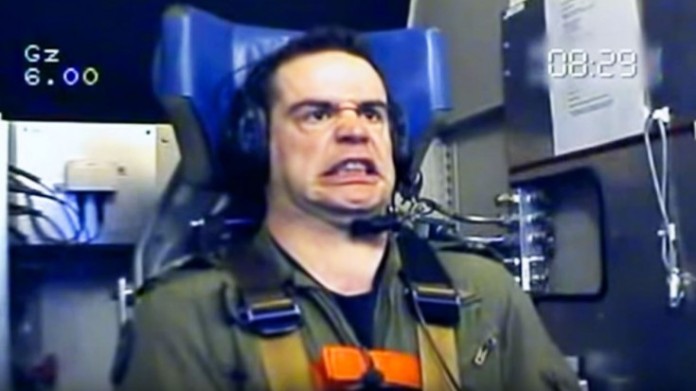
(Source.)
At 200 RPM, the heat shield, experiencing 77 gees of centrifugal acceleration, cracks and flies off. It’s possible that the kick it gets from leaving our sorry asses behind, combined with the kick from being in the hole’s ergosphere (sounds dirty) is enough to slingshot the fragments to safety. Kind of a moot point, though, since I only care about the human parts, and all of those have blacked out at 13 gees.
Somewhere between 200 RPM and 500 RPM, the hull finally tears open. The bottom dome is flung off, letting important things like our air, our barf bags, and possibly our crew couches, fly out. Not that it matters: at 83 gees, we’ve all got ruptured aortas, brain hemorrhages, and we’re all in cardiac arrest.
At 1000 RPM (16.7 revolutions per second), the command module is flung decisively apart. Thanks to conservation of angular momentum, all the pieces are spinning pretty fast, too. Jürgen, Charlize, and I, are very dead, and in the goriest of possible ways: pulped by centrifugal force, and then shredded as we were spun apart.
The fragments closer to the horizon appear to accelerate ahead of us. The parts farther away fall behind. Most of the fragments fall into the hole. Spaghettification takes a while: once again, a more massive hole has weaker tides near the horizon.
As for what happens as we fall into the really nasty part of the hole (because it was sunshine and jellybeans before…), physics isn’t sure. The simplest models predict a ring-shaped singularity, rather than a point-shaped one. Some models predict that the ring singularity might act as an actual usable wormhole to another universe. But it’s also possible that effects I don’t pretend to understand (which have to do with weird inner horizons only rotating holes have) blue-shift the infalling light, creating a radiation bath that burns our atoms into subatomic ash. Either way, we’re not going to be visiting any worlds untold.
Once again, I’ve killed myself and two much cooler people. At least I only did it once this time. In the next and final part, I’m going to spend a little more time playing around with far less realistic black holes. (WARNING! Don’t actually play with black holes. If you have to ask why, then you skipped to the end of both articles.)

